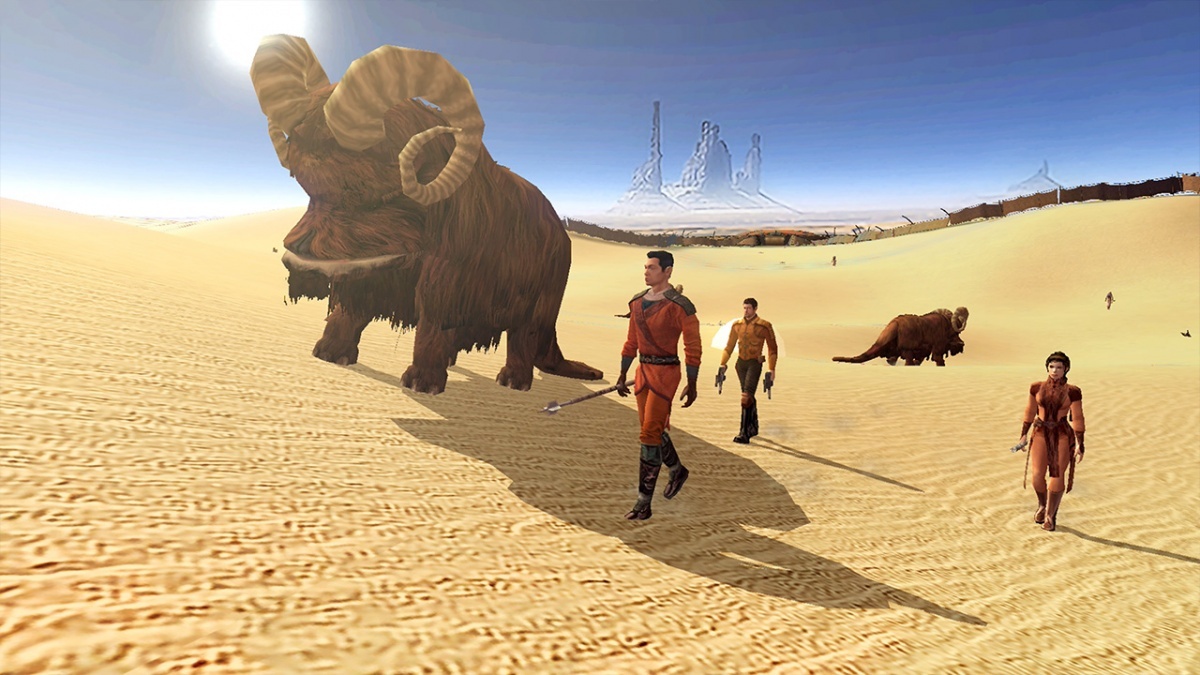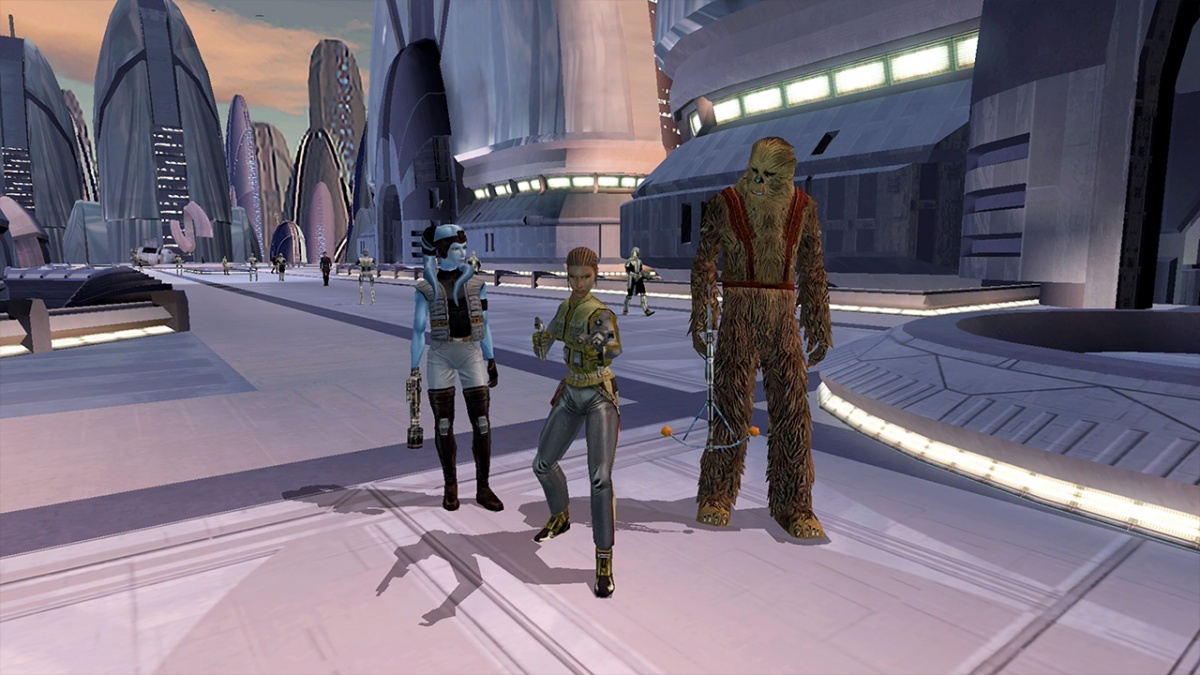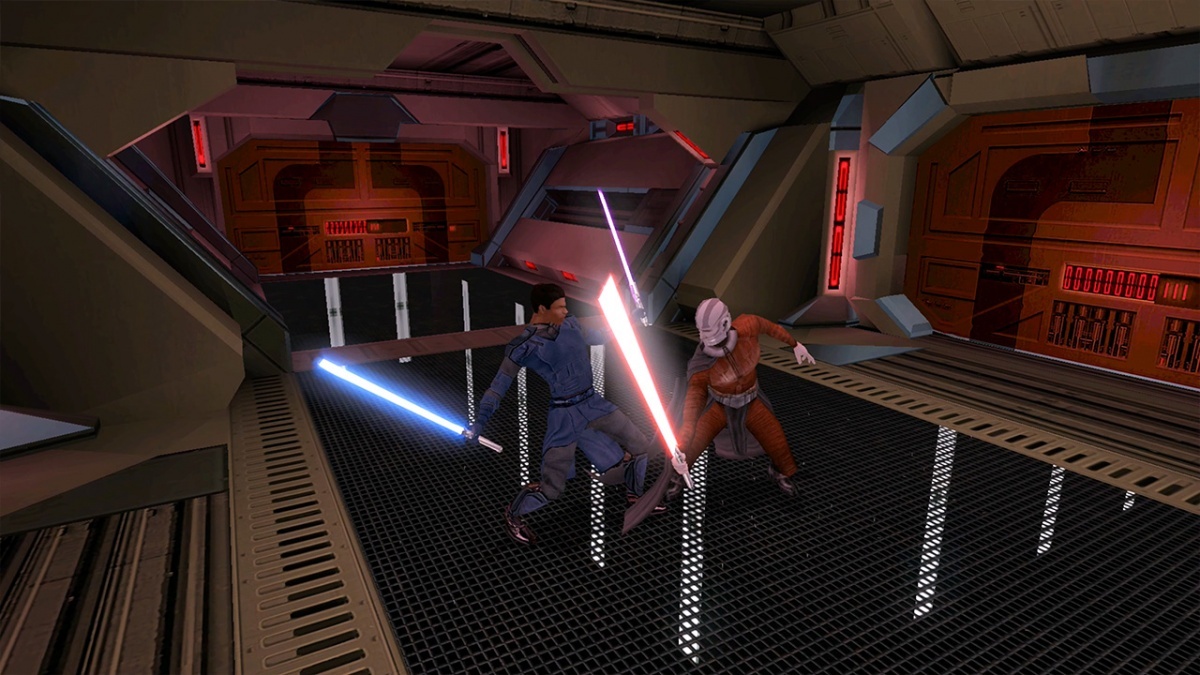Knights of the Old Republic (Nintendo Switch) Review
By Michael McCann  29.03.2022
29.03.2022

There have been a lot of Star Wars titles released over the years and as shocking as that fact is (Emperor Palpatine style!) many of them are fondly remembered and well regarded to this day. No siree. It really doesn't get mentioned enough. Until relatively recently videogames that were based on existing entertainment franchises were widely considered pejorative and, excuse the strong language that's about to be used here, dank. Cash grabs, amongst other things. And although one of the largest global entertainment phenomena this side of Not Going Out hasn't been totally immune to the judgement, it has had a surprisingly high hit rate over the last few decades. Perhaps it is just simply the law of large numbers in full bloom, flowering in patches over a vast stary meadow. Whatever it is it is under no speculation that the world of Star Wars is ripe for the plucking. Disney, and its giant bag of 4 billion dollars, knows this.
The consensus seems to be that Knight of the Old Republic is one of the best of its kind. That is, not only one of the best Star Wars licensed titles, but also one of the very best video games of all time, plain outright, topping listicles headlined similarly, from all manner of mainstream publication, shortly after its release. To this day Knights of the Old Republic remains on these perpetual best-of-all-time lists, but it hasn't had quite the same kind of staying power or timelessness of something like a Nintendo classic, for example, to retain its place in the upper echelons of the collective mindset.
Originally developed by BioWare and released as a console exclusive for Xbox back in 2003, this is a time capsule to a very specific dogma and a very specific period in game design. So much is this the case, that it was seeming like it was on the way to becoming a slightly forgotten about "all-time," before the announcement in September of 2021 of a full-blown remake being in development, shortly followed by the news of this: a Nintendo Switch port of the original title, presented mostly as-is (and presumably also to brush up the Aspyr team on the source material before production on the remake goes full steam ahead) albeit with some tweaks and minor modern improvements, much to the rejoice of long-time fans.
Okay, here's the thing: this is dated when comparing it to the modern RPG standards of 2022. Severely dated. Menus are big and clunky; assets and character models are reused, pervasively so, even in prominent roles; environments are confusing and often laterally indistinct thus also occasionally making navigation confusing, whilst elsewhere invisible walls will fence off wider areas inexplicably; the implementation for fast-travel is arcane; character and camera movement is as rigid as much as it is slow; and character perk trees, enemy AI and general interaction within the world is, with regards to action at the very least, relatively basic.

The audio and FMV quality are the worst dated offenders when spying at the wrinkles thru the lens of retrospective time. Most likely it's a result of the state assets were left in, in the archives, but the quality here at best can be described as "spotty" - compressed into oblivion and littered with technical errors throughout. After it's triggered some of the audio will cut out completely before the playback completes and, encountered when visiting Tatooineone for the first time, is one of the most hilarious and phoned-in Scottish accents that's ever been recorded by anyone, ever. Like Sean Connery emerging from a refuse sack full of sardines after several continuous nights on the lash. What's that all about!? It's specific evidence that gives the best sense of a disconnected or uneven performance capture process, something that is much less likely to occur in current times and is truer for tertiary NPC dialogue, whereby consecutive lines of dialogue can be delivered by the exact same actor in noticeably differing tones, speeds and, in this instance, accent.
By far, the most egregious issue plaguing this port-job is one of the badly degraded FMV. It visually tears and artefacts substantially over the dark areas of its reproduction really badly, ruining what is otherwise strong buttressing for the world-building and overall pace of the main narrative. Incidentally, Knights of the Old Republic was criticised in 2003 for containing too many in-engine cut-scenes, as opposed to FMV, as the graphical fidelity wasn't quite up there to be desired at the time. With the benefit of hindsight, and the obvious advancements in graphical technology since, seeing the degradation of these assets here makes a great case for why it might be better to always go with in-engine cutscenes, even if it's just for preservation's own sake. Contrarily to this point, there is something that is appealing and even nostalgically yearning for, for the mixed aesthetic, for that which the juxtaposition affords.
Regardless, the scope of the original was revolutionary back in 2003, and that can't be enervated too harshly by the space of time between then and now. It was a rarity for every character to be voice-acted, which they are, and to further promise a non-linear interplanetary hopping adventure on such a grand scale. The ambition for the time that it was originally released cannot be understated and it was a huge sales driver for Microsoft's original big black box. Thankfully, despite criticisms of age, the appeal of this scope and immersion still shines through in 2022, and it clearly lays the groundwork for the later successes of Bioware's more polished Mass Effect series. More importantly, the characters, side stories and the overarching narrative remain as engaging as they ever were, representing the "feel" and brand of Star Wars well, even if much of it is repurposing established tropes and archetypes from the series as a whole in a skew-whiff fashion.
The story is set thousands of years prior to the original movie trilogy, in a galaxy, far, far away - the Sith are getting a foothold in the early Galactic Republic after defectors within the Jedi were disillusioned by the order's reticence to get involved in the Mandalorian Wars. The amnesiac, and voiceless protagonist, wakes after being created in the (also quite anaemic) character creator (and whom may or may not be Force-sensitive, but almost certainly is, or will be) and will, of course, play a pivotal role in stopping the impending Sith invasion by seeking to destroy the Star Forge, a source of Sith energy and military production. Without going into further detail of the plot, it's easy to see the appeal and why a lot of people like Knights of the Old Republic, even after all this time. It's the de facto hero's journey, full of great story beats, twists and turns, and more moral quandaries than Yoda himself could shake a stick at… because he likes to do that, he does. Zounds! For a Star Wars fan this is essentially a full-on Jedi fantasy fulfilment simulator. This is the bottom line and hard to deny the intoxication of. The main big-bad, Darth Malak, is well established in cut-scenes, and is a great Star Wars villain that rivals the best of the worst of them - which, if it was being based on the number of arms, is General Grievous.

The Ebon Hawk, a starship that acts as home base and a hub between missions, will in due course be populated with a ragtag cast of disparate but likeable and well-written characters, and then two of them can be selected to join a scouting party for jaunts outside of the Ebon Hawk. Characters bounce off one another and personalities clash as they assist in combat and can affect the story in ways that are conditional on the choice that has been made. Spending time with each of these characters over the course of the adventure will reveal more about them personally and their individual stories, and some of these are just as rewarding as the main questline. A particular favourite crewmate is HK-47, a droid with an unexplained penchant for murder and violence. Uncovering why this is and the mystery of a previous owner stood out as a particularly memorable side story. They are not at all necessary for story completion, but they do pay off either, as aforementioned, narratively or with buffs and abilities that will be granted to characters respectively.
It's little wonder why Knights of the Old Rebublic is one of the few the Star Wars Legends, pre-acquisition, pre-Lucas abdication stories, outside that of the mainline movies, that Disney hasn't out-right retconned as part of the canon - with rumours of the company using Knights of the Old Rebublic as source material for future development of a TV or film adaptation. Although it should be mentioned, the fact that there has been no cultural or technological advancement or diversion in the thousands of years between the era of the Old Republic and A New Hope is a little disconcerting.
Gameplay is a mixture of exploration, amassing loot, dungeon crawling, dialogue trees, skill checks, fetch quests and semi-turn-based combat. It's a formula that will be familiar to anyone that understands the established, Westernised RPG fare, but also, due to its age, it feels novel in execution or, even more so now, in the way that it interfaces with said established Western RPG fare. A large reticule remains on the screen at most times, highlighting objects, characters and potential targets, of which can be cycled with the back shoulder buttons, and an interaction menu in the bottom left of the HUD utilises the D-pad (kind of reminiscent of the PlayStation XrossMediaBar navigation) for selection of available context-sensitive actions by category.
This kind of implementation possibly wouldn't be employed in a modern RPG today (Although, possibly the Final Fantasy 7: Remake and Xenoblade series might want a word), but, if even somewhat inelegant, there isn't actually anything much fundamentally wrong with this UI set up at all. It seems like something that could be expanded on or streamlined, has dipped for no other reason than a trend to imitate perhaps more immersive, casual and commercially successful examples. But what it does do is give the title an interesting, even refreshing hybrid feel between that of an RPG, a point-and-click adventure, and something that is a bit more action-orientated. There's also frequent opportunity to mix up the core gameplay, which is always welcomed, from the optional game of Pazaak or Swoop races, to sitting in the gunner seat of the Ebon Hawk or solving word-play murder mysteries.

Combat happens in real-time automatically, however, the player is able to position an active character manually at any time. The effectiveness of characters in battle will be decided on a dice roll, essentially, in conjunction with their character stats. The L button then is used to pause skirmishes so that actions can be queued up or to further consider strategies. Once decided characters will be locked into animation until the next move. There are many angles to come at battles from, from using Jedi powers, such as mind control or force lightning, to taking a more ranged approach or utilising acquired items such as shields and grenades. Every strategy is relevant, and all can bear the fruits of a sweet, sweet victory. Morality is, of course, a big part of Knights of the Old Republic, and it dictates what force powers will be available to a given build. It does allow for mixing and matching of light side and dark side powers though, just at the cost of more points. Otherwise, points can be pumped into attributes such as computer hacking, stealth, or charm, which, albeit nascent manifestations of those mechanics, can sometimes allow for the circumnavigation of a direct conflict altogether.
The combat can get surprisingly frantic too, and the sway of battle can change in an instant. It can seem a little unbalanced at times, encouraging save spamming, although mileage may vary due to individual character builds and it's a relief that fallen allies still receive XP for a battle won. Certainly, allowing the auto-levelling to distribute stat points for secondary party members did lead to some questionable decisions made by the system and no doubt contributed to an extremely challenging end-game (which to be fair did make for an epic and satisfying conclusion), which does make one wonder if it is possible to hamstring a playthrough due to this. It'd be remiss not to mention the giant text prompt which is by now an inclusion that's infamous and quite the talking point for this port. It appears on the top third of the screen during enemy engagement and, though not to repeat too much what has already been said by others, it is an intrusive element, dominating a silly amount of screen real estate. Though it's only a minor annoyance it simply isn't necessary. Aspyr has recently released a patch to fix the issue and though it is a marked improvement over launch it could still take up less space on the screen.
This generally feels convincingly alive. It's impressive for a title that's nearly twenty years old. The world feels lived in with NPC's going about their business, ships taking off and landing in busy spaceports, and cities that feel denser than they actually are, or suggest a larger world outside the aspect that one is seeing it. Small details like flocking birds in the sky and the Open GL reflections still look good and really help with the immersion. The bloom post effects too, even if it might be something only added for the remaster (and perhaps it is a little overcooked at times) can deceive the eyes to the low-poly graphics that are actually on display. It's all looks crisp and comfortable at 1080p and wide-screen support during gameplay, with the score, which sounds a bit like Tomb Raider's PS1 score at times, contributing massively to the overall presentation and tone. The only real exception to this is Wookie planet, Kashyyyk, which looks and sounds like a dog-dinner at all times. The Thykarann-speak in particular gets really grating in this locale. Factor in quick loading times too and this probably is the best way to experience the original Knights of the Old Republic that there currently is.

Cubed3 Rating
Very Good - Bronze Award

It's a strange one. There couldn't be a title that's more due of a remake yet also still a really good time as Knights of the old Republic. Although it came out around the same time as when the prequels were in cinemas, it has more in kin with the classic trilogy insomuch as what was once cutting edge is now low-fi and that very aspect comprises a large part of the charm. Not without issues, but to focus on those issues in the harsh light of day would feel too much like pestering an old person for losing their teeth - an influential old person, with lots of great stories. So, while a remake is most welcome one does wonder if it'll lose something in the translation about what makes this version work. It's the OG that captures the scale of the Star Wars Universe unlike any other Star Wars game. It absolutely deserves play in 2022.

Star Wars: Knights of the Old Republic
![]() 7/10
7/10
![]() 0
(0 Votes)
0
(0 Votes)
 None
None  None
None  None
None  None
None Comments
Comments are currently disabled

 Sign In
Sign In Game Details
Game Details Subscribe to this topic
Subscribe to this topic Features
Features





 Top
Top

